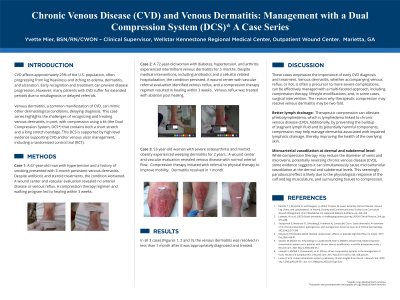Case Series/Study
(CS-098) Chronic Venous Disease (CVD) and Venous Dermatitis: A Case Series
Friday, May 2, 2025
7:45 PM - 8:45 PM East Coast USA Time

Introduction: CVD affects approximately 25% of the U.S. population, often progressing from leg heaviness and itching to edema, dermatitis, and ulceration. Early recognition and treatment can prevent disease progression. However, many patients with CVD suffer for extended periods due to misdiagnosis or delayed referrals.
Venous dermatitis, a common manifestation of CVD, can mimic other dermatological conditions, delaying diagnosis. This case series highlights the challenges of recognizing and treating venous dermatitis, in part, with compression using a kit that contains both a short stretch and a long stretch bandage.
Methods: Case 1: A 67-year-old man with hypertension and a history of smoking presented with 3-month persistent venous dermatitis. Despite antibiotic and steroid treatments, the condition worsened. A wound center and vascular evaluation revealed no arterial disease or venous reflux. A compression therapy regimen and walking program led to healing within 3 weeks.
Case 2: A 72-year-old woman with diabetes, hypertension, and arthritis experienced intermittent venous dermatitis for 5 months. Despite medical interventions, including antibiotics and a cellulitis related hospitalization, the condition persisted. A wound center with vascular referral evaluation identified venous reflux, and a compression therapy regimen resulted in healing within 3 weeks. Venous reflux was treated with ablation post healing.
Case 3: 53-year-old woman with severe osteoarthritis and morbid obesity experienced weeping dermatitis for 2 years. A wound center and vascular evaluation revealed venous disease with normal arterial flow. Compression therapy initiated with referral to physical therapy to improve mobility. Dermatitis resolved in 1 month.
Results: In all 3 cases, the venous dermatitis was resolved in less than 1 month after it was appropriately diagnosed and treated.
Discussion: These cases emphasize the importance of early CVD diagnosis and treatment. Venous dermatitis, often a precursor to more severe complications, can be effectively managed with a multi-faceted approach, including compression therapy, lifestyle modifications, and, in some cases, surgical intervention.
Venous dermatitis, a common manifestation of CVD, can mimic other dermatological conditions, delaying diagnosis. This case series highlights the challenges of recognizing and treating venous dermatitis, in part, with compression using a kit that contains both a short stretch and a long stretch bandage.
Methods: Case 1: A 67-year-old man with hypertension and a history of smoking presented with 3-month persistent venous dermatitis. Despite antibiotic and steroid treatments, the condition worsened. A wound center and vascular evaluation revealed no arterial disease or venous reflux. A compression therapy regimen and walking program led to healing within 3 weeks.
Case 2: A 72-year-old woman with diabetes, hypertension, and arthritis experienced intermittent venous dermatitis for 5 months. Despite medical interventions, including antibiotics and a cellulitis related hospitalization, the condition persisted. A wound center with vascular referral evaluation identified venous reflux, and a compression therapy regimen resulted in healing within 3 weeks. Venous reflux was treated with ablation post healing.
Case 3: 53-year-old woman with severe osteoarthritis and morbid obesity experienced weeping dermatitis for 2 years. A wound center and vascular evaluation revealed venous disease with normal arterial flow. Compression therapy initiated with referral to physical therapy to improve mobility. Dermatitis resolved in 1 month.
Results: In all 3 cases, the venous dermatitis was resolved in less than 1 month after it was appropriately diagnosed and treated.
Discussion: These cases emphasize the importance of early CVD diagnosis and treatment. Venous dermatitis, often a precursor to more severe complications, can be effectively managed with a multi-faceted approach, including compression therapy, lifestyle modifications, and, in some cases, surgical intervention.

.jpg)